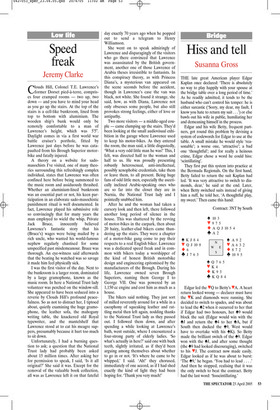Speed freak
Jeremy Clarke
Clouds Hill, Colonel T.E. Lawrence’s former Dorset pied-à-terre, comprises four cramped rooms — two up, two down — and you have to mind your head as you go up the stairs. At the top of the stairs is a cell-like bunkroom, lined from top to bottom with aluminium. The wooden ship’s bunk would only be remotely comfortable to a man of Lawrence’s height, which was 5'5". Daylight comes in via a first world war battle cruiser’s porthole, fitted by Lawrence just days before he was catapaulted from his Brough Superior motorbike and fatally injured.
A theory on a website for sadomasochists I’ve visited, one of many theories surrounding this refreshingly complex individual, states that Lawrence was often confined here before being summoned to the music room and assiduously thrashed. Whether an aluminium-lined bunkroom was an essential part or not, his keen participation in an elaborate sado-masochistic punishment ritual is well documented. In fact, Lawrence played his submissive role so convincingly that for many years the man employed to wield the whip, Private Jack Bruce, innocently believed Lawrence’s fantastic story that his (Bruce’s) wages were being mailed by a rich uncle, who wanted his world-famous nephew regularly chastised for some unspecified past misdemeanour. Bruce was thorough. An eye-witness said afterwards that the beating he watched was so savage it made him feel physically sick.
I was the first visitor of the day. Next to the bunkroom is a larger room, dominated by a large gramophone, known as the music room. In here a National Trust lady volunteer was perched on the window-sill. She appeared to have been seduced into a reverie by Clouds Hill’s profound peacefulness. So as not to distract her, I tiptoed about, quietly examining the huge gramophone, the leather sofa, the mahogany writing table, the knackered old Royal typewriter, and the mantelshelf that Lawrence stood at to eat his meagre suppers, presumably because it hurt too much to sit down.
Unfortunately, I had a burning question to ask; a question that the National Trust lady had probably been asked about 15 million times. After asking her for permission to speak, I said, ‘Is it all original?’ She said it was. Except for the removal of the valuable book collection, all was as Lawrence left it on that fateful day exactly 70 years ago when he popped out to send a telegram to Henry Williamson.
She went on to speak admiringly of Lawrence and disparagingly of the visitors who go there convinced that Lawrence was assassinated by the British government, another one of those Lawrence of Arabia theses irresistible to fantasists. In this conspiracy theory, as with Princess Diana’s, a mysterious van appeared on the scene seconds before the accident, though in Lawrence’s case the van was black, not white. She found it strange, she said, how, as with Diana, Lawrence not only obsesses some people, but also still provokes strong feelings, either of love or antipathy.
Two more visitors — a middle-aged couple — came clumping up the stairs. They’d been looking at the small audiovisual exhibition in the garage where Lawrence used to keep his motor-bikes. As they entered the room, the man said, a little disgustedly, ‘What a very odd little man he was!’ This, I felt, was directed half to the woman and half to us. He was proudly presenting robustly heterosexual, anti-intellectual, possibly xenophobic credentials, take them or leave them, to all present. Being huge fans of odd little men, especially the ascetically inclined Arabic-speaking ones who are so far into the closet they are in Narnia, the National Trust lady and I pointedly snubbed him.
After he and the woman had taken a cursory look and then left, there followed another long period of silence in the house. This was shattered by the revving of motor-bikes in the carpark, then about 20 hairy, leather-clad bikers came thundering up the stairs. They were a chapter of a motor-bike gang come to pay their respects to a real English biker. Lawrence was a dedicated speed freak and in common with bikers today a worshipper of the kind of honest British motorbike design and engineering epitomised by the manufacturers of the Brough. During his life, Lawrence owned seven Brough Superiors, naming them George I to George VII. One was powered by an 1,150 cc engine and cost him as much as a house.
The bikers said nothing. They just sort of milled reverently around for a while in a cacophony of squeaking leather and rattling metal then left again, nodding thanks to the National Trust lady as they passed out. I followed them down, and after spending a while looking at Lawrence’s bath, went outside, where I encountered a four-strong party of elderly ladies. ‘So what’s actually in here?’ said one with buck teeth, slightly irritated, as if they’d been arguing among themselves about whether to go in or not. ‘It’s where he came to be whipped,’ I said. ‘Ah!’ they chorused, immediately of one accord, as if I had shed exactly the kind of light they had been hoping for. ‘Thank you very much!’



















































 Previous page
Previous page